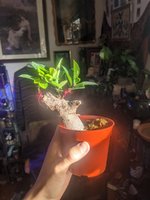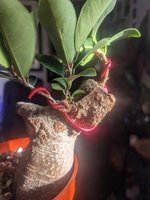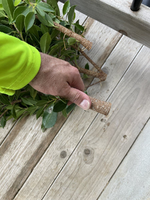August
Chumono
Hey again,

I got this ficus in late spring from a person who I dogsit for, in their own words, they "needed less things to worry about keeping alive", a sentiment I completely understand.
Needless to say, it was in pretty rough shape, hadn't seen more than an hour of sunlight in years, and had a ton of suckers. In my initial cutback I cut it back to three branches that I was pretty sure we're above the graft.
Recently pruned and wired (please excuse the insane wire gauge and withhold from goofing me) and as the new leaves have filled in, I think I might have misjudged how much of the graft has survived.
First picture is the honorary "front", on the left you can really see the smaller leaves and what I (almost) certainly believe to be part of the graft.
Below, a better view of that one branch:

The branches on the back are right on the line of where the obvious (clunky) graft was done.

You can really see how big those leaves are in that picture.
Am I wasting my time with those branches? I have considered the possibility of just continuing with that left branch, in fact I might even appreciate it more that way.
Another question comes to mind now, since this tree is still in such an early stage. If those back branches are below the graft as I fear, would it be better to keep them to promote energy and health as I develop the top, or would the energy being used to support them be better off sent to the graft?
If you made it this far, thanks for reading this absolute manuscript.

I got this ficus in late spring from a person who I dogsit for, in their own words, they "needed less things to worry about keeping alive", a sentiment I completely understand.
Needless to say, it was in pretty rough shape, hadn't seen more than an hour of sunlight in years, and had a ton of suckers. In my initial cutback I cut it back to three branches that I was pretty sure we're above the graft.
Recently pruned and wired (please excuse the insane wire gauge and withhold from goofing me) and as the new leaves have filled in, I think I might have misjudged how much of the graft has survived.
First picture is the honorary "front", on the left you can really see the smaller leaves and what I (almost) certainly believe to be part of the graft.
Below, a better view of that one branch:

The branches on the back are right on the line of where the obvious (clunky) graft was done.

You can really see how big those leaves are in that picture.
Am I wasting my time with those branches? I have considered the possibility of just continuing with that left branch, in fact I might even appreciate it more that way.
Another question comes to mind now, since this tree is still in such an early stage. If those back branches are below the graft as I fear, would it be better to keep them to promote energy and health as I develop the top, or would the energy being used to support them be better off sent to the graft?
If you made it this far, thanks for reading this absolute manuscript.



